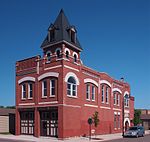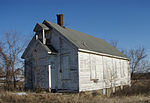Eagle Newspaper Office
Buildings and structures in Wright County, MinnesotaCommercial buildings completed in 1885Commercial buildings on the National Register of Historic Places in MinnesotaDefunct newspaper companies of the United StatesItalianate architecture in Minnesota ... and 4 more
National Register of Historic Places in Wright County, MinnesotaNewspaper buildingsNewspaper headquarters in the United StatesPrinting in the United States

The Eagle Newspaper Office is a historic commercial complex in Delano, Minnesota, United States, comprising three adjacent buildings constructed 1883–1885. It served as the headquarters of the Delano Eagle newspaper and a print shop specializing in railroad and commercial printing, as well as bookbinding. It was listed on the National Register of Historic Places in 1979 for having local significance in the theme of communication. It was nominated as the home of Delano's oldest business and a newspaper that had served the community continuously since its founding in 1872.
Excerpt from the Wikipedia article Eagle Newspaper Office (License: CC BY-SA 3.0, Authors, Images).Eagle Newspaper Office
Railroad Avenue,
Geographical coordinates (GPS) Address Nearby Places Show on map
Geographical coordinates (GPS)
| Latitude | Longitude |
|---|---|
| N 45.040833333333 ° | E -93.786111111111 ° |
Address
Railroad Avenue 307
55328
Minnesota, United States
Open on Google Maps






